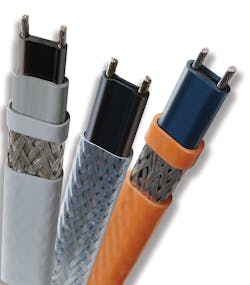Petrochemical plants have many thousands of feet of electric heat tracing. It’s used primarily for winterization or process heating. Winterization protection protects lines and vessels from freezing during the colder months. Process heating keeps the pipes and vessels warm to enable the system to function properly. For instance, many times a product will condense or solidify at ambient temperature. Therefore, the piping system or vessel must be kept at a higher temperature to maintain a vapor or liquid form so it will flow through the pipes.
The National Electrical Code (NEC) addresses all different forms of electric heat tracing in Art. 427. Among the methods addressed are: Impedance Heating Systems; Induction Heating Systems; Resistance Heating Systems; and Skin-Effect Heating Systems. Resistance heating is by far the most common you’ll find in a refinery or chemical plant. Resistance heating systems are mainly categorized in two types of systems:
1) self-regulating, parallel-resistance cables and
2) series-resistance cables (such as MI cables).
Self-regulating cables are a parallel type heating system that employs a dielectric material extruded between two conductors. As the temperature falls, the dielectric allows more current to flow between the two conductors, thus allowing more I2R heating to be produced. As the temperature gets warmer, the current flow lessens, which allows the cable to cool — thus, the name “self-regulating.” Self-regulating cables are typically used on low- to mid-temperature systems, relatively speaking.
Another type of resistance electric heat tracing is series resistance. Series resistance systems are highly engineered as the exact length of cable must be designed to obtain the desired cable power output. These types of cables are available in both flexible (cut-to-length) and factory-fabricated MI cables. Flexible series resistance cables are available in two- or three-conductor configurations, and have the ability to be cut and easily installed in the field. MI cables are used where higher temperatures must be tolerated and self-regulating or flexible series resistance cables could be damaged by the temperatures encountered. MI cables are typically constructed of Alloy 825 and, therefore, are more labor intensive to install.
The NEC requires all heat tracing to be protected against ground faults with a couple of exceptions noted in Sec. 427.22. There is big a difference between the ground-fault circuit interrupters (GFCIs) that are used for personnel and equipment protection. Personnel GFCIs typically have a trip threshold between 4mA to 6mA — barely enough to detect a shock. Heat-tracing equipment has a protection trip threshold of approximately 30mA, which is enough current to cause significant shock to personnel. There are many other requirements for electrically traced equipment in the NEC, such as marking requirements found in Sec. 427.13.
NEC Chapter 5 also applies to electric heat tracing found in hazardous (classified) locations, which is typical in industrial petrochemical facilities. Since electric heat tracing is a heat source, it must comply with Secs. 501.135, 502.135, and 503.135, or Art. 505 or Art. 506.
© 2016 Fluor Corp. All Rights Reserved.
About the Author
Eddie Guidry
Senior Fellow
Eddie Guidry is a senior fellow with Fluor Enterprises, Inc., Sugar Land, Texas. He is highly skilled in electrical and control systems for industrial construction, design, and engineering (both domestic and abroad). The majority of Eddie’s 38 years of experience includes upstream and downstream portions of petrochemical plants and refineries. He is also heavily experienced in water and wastewater treatment facilities. Eddie is very active in the development of U.S. national (ANSI) and international codes and standards, and has been a principal member of the National Fire Protection Association (NFPA) National Electrical Code (NEC) committee since 1999 and NFPA’s National Advisory Committee on Electrical Safety Research since 2008. Eddie, who has also developed and conducted many electrical courses and seminars over the years, currently holds the corporate Master Electrician license for Fluor Corporation in the State of Texas and is also an ICC/IAEI certified electrical inspector.

